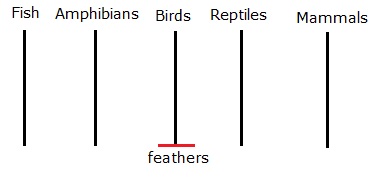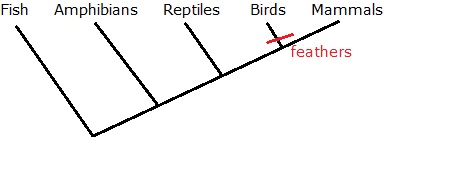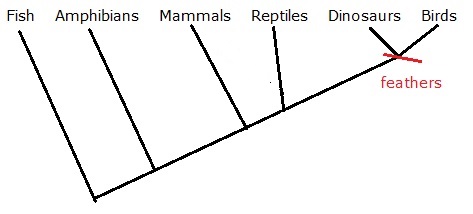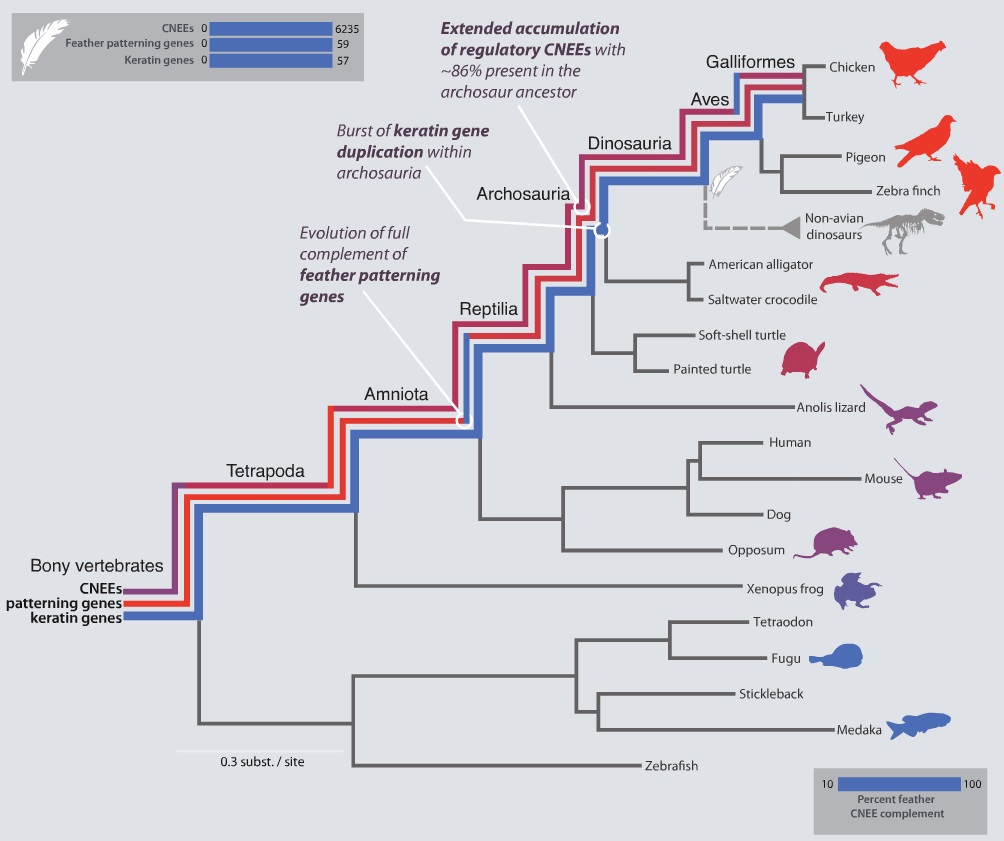There’s a lot of really exciting work going on in genome comparisons. My recent review on the cats highlights some of the power of this kind of work.
Another, similar piece of work was recently released. Titled “Feather development genes and associated regulator innovation predate the origin of Dinosauria”[1], the work compares the whole genomes of four birds (including chickens), two crocodilians, two turtles, a lizard, four mammals, a frog, and five ray-finned fish.
Centuries ago, the innovation of feathers was thought to be something like this
This was pretty simple and obvious to the people of the time. There were fish and amphibians and reptiles and birds and mammals. Each of them have specific characters that they others don’t have. And offspring always look a lot like their parents. We don’t see frogs laying eggs that hatch turtles, for example.
And that view fit the prevalent beliefs of the period as well. It matched the stories told in the holy books. This view is still held by creationists to this day.
Then we started with all this talk of evolution, how populations of organisms change over time and how there was a common ancestor of many groups of organisms. One example is that all tetrapods (mammals, reptiles, amphibians and birds) share the limb pattern of one big bone, two smaller bones, and many bones at the end of the limb. There are variations, sure, but all tetrapods have this base trait. Another example, all mammals, reptiles, birds, and amphibians have gill arches in their early embryonic form. Those become different things in different organisms, but all tetrapods share that character.
The diversity of life began to look something like this.
This still shows the sudden appearance of feathers in the birds. This presents something of a problem for those who supported evolution. Feathers are highly complex things and flight feathers even more so. They still popped into existence, so there still is support for a deity.
Before Darwin began his journey on HMS Beagle, there were discoveries. One of the earliest known fossil discovery that was recorded was in the Sichuan Province of China. Chang Qu wrote about the discovery of dragon bones sometime in between 265 CE and 316 CE. These dragons, which came to be called dinosaurs, where amazingly diverse and then, in 1861, something amazing was found in Germany.
We found Archaeopteryx. Which, despite the feathers still had more characteristics of the dinosaurs than it did birds. It was the first dinosaur that we discovered that had feathers, but it wouldn’t be the last. Over the last 150 we have discovered hundreds of types of dinosaurs that have feathers, including the tyrannosaurs[2]. Yep, the king of the dinosaurs was covered in feathers like a giant carnivorous ostrich.
Now our picture looked more like this
But that’s only part of the story. As we are just really finding out, the real change agent aren’t always the genes that make the proteins (in the case of feathers it’s 67 keratin genes), but it’s the regulatory genes. And those genes are much, much older than the protein genes.
Which brings us back around to our paper. The authors analyzed the genenomes of 5 fish, 4 birds, four mammals, two crocodilians, 2 turtles, a lizard, and an amphibian. [Is it to much to ask that one of the birds was a partridge in a pear tree?]
They found 193 feather related genes, of which 67 were for the proteins that form feathers. But the remaining 126 are all regulatory genes. Not unsurprisingly, the genes for keratin formation were much more likely to only appear in birds. Much more so than even the authors expected.
I’ll quote the paper here, because the authors said it best.
Surprisingly, the CNEEs associated with non-keratin feather related genes show the highest rate of origin not on the internode between the ancestral archosaur and birds, where they exhibit a 25% higher-than-expected rate of origination, but instead on the branch leading to amniotes, where they exhibit a rate of origination 60% higher than expected (Figs. 1 and 2, Supplementary Fig. 1).
CNEEs are conserved non-exonic elements, these are considered important regulators of gene expression [3]. So, these elements were not developed hand in hand with the keratin genes, but all the way back to the common ancestor of all organisms that can lay eggs on land, they have an amnion.
Thirty two of those CNEEs are shared with the gene set that is involved with the development of hair in mammals.
The authors say that their evidence suggests that all dinosaurs, not just the birds, have the entire non-keratin genetic toolkit to make feathers. Further, 86% of those CNEEs were present in the ancestor to archosaur (the clade that contains all birds and crocodiles (and therefore includes all dinosaurs)).
Now, the tree looks more like this (from the paper)
I do need to note here, that this image has some problems. The PDF, for some reason, isn’t displaying colors properly. Their should be gradations from blue to red in the grey boxes and those gradations match the color of the organisms on the right.
This is consistent with the evidence of the appearance of feathers or feather-like structures in Archosauria. These types of structures appear in pterosaurs, ornithiscian and theropod dinosaurs. Basically, the ability to make feathers and the feather precursors were present more than 100 million years prior to the appearance of modern feathers.
The appearance of the keratin producing genes are quite well known. The authors identify (via references to previous research), 57 beta keratin genes that appeared in the expansion of a gene cluster and 5 from gene duplication events. The analysis of the authors, showed this burst of genetic novelty as other researchers have (lending further support to the timing of the origin of the keratin genes).
But while the proteins themselves are important in feather formation, the regulation genes for the proteins aren’t. The non-keratin regulatory pieces are much more important.
The authors go on to describe the changes in regulatory genes that reduced the size of dinosaurs changes to limb lengths in Maniraptora that preceded the development of flight. Part of the interest of dinosaurs is their vast diversity, from organisms smaller than a chicken to the largest land animals, by far, to ever exist.
The authors found that the regulatory genes are the one involved in this process as well. The birds in this genome study had surprisingly large amounts of regulatory genes in the areas that are responsible for growth proteins and limb development.
Long story short, what this all means is that, regulatory genes are older and more important in evolutionary innovation than the genes that make the proteins.
When we think about the simplest way to do something (genetically), that makes sense. To make a person taller, the body doesn’t have to modify the protein in every bone, every muscle, and every nerve. It’s just one (or a small number) of high level regulatory genes that do the job.
That’s why we can easily get mutants with multiple limbs, all with the correct bone structure and number of digits. It’s not a copying of the entire suite of proteins that make a limb. It’s a single copy mistake in a regulatory gene. This has been shown in fruit flies for a long time.
While I don’t want to, I think it important that I talk briefly about the creationist idea of front-loading. That is, god I mean, the intelligent designer, has preloaded all the genetic information into every organism so that evolution can happen and creationists can still talk about design.
There’s a problem with this though. Yes, the regulatory genes were present in the ancestors of archosaurs over 100 million years before feathers began to appear on dinosaurs in the fossil record.
But the keratin genes didn’t appear until much later. And that’s where front-loading fails. Think about it, 100 millions of evolution and the designer somehow knew that birds and not crocodiles would develop the keratin gene. Or that mammals wouldn’t get the keratin genes instead, but not have the regulatory network needed for feathers.
The creationists who use this argument are proposing that the information for the keratin genes was already present, just waiting on evolution to get to the dinosaurs before allowing the keratin genes to appear and all traces of the genetic information has disappeared from the other populations that have the regulatory genes, but not the keratin producing genes.
What is much more likely to be true is the idea of constraint. Evolution works with what is available. You will never see a dog give birth to a goat. And even if you selectively bred a group of dogs for tens of thousands of years to look like a goat, they would not be goats. Evolution is constrained by what came before. Vertebrates have inside-out retinas, and hernias, and many other weird features that only make sense when we look at the evolutionary history of our species instead of just assuming we’re the pinnacle of creation.
This research doesn’t support front-loading. It supports evolution. Birds, mammals, turtles, and crocodiles all have some of the same genes with minor changes and those changes are more different the farther away you go on the evolutionary tree. That’s evidence of evolution and not just evolution within species, but evolution from one species into many others.
EDIT: Problem with my original cladograms (as noted by Nick below) and added the cladogram from the paper.
___________________________
[1] Lowe, C., Clarke, J., Baker, A., Haussler, D. & Edwards, S. Feather development genes and associated regulatory innovation predate the origin of Dinosauria. Molecular Biology and Evolution msu309 (2014). doi:10.1093/molbev/msu309
[2] Xu, X.; Wang, K.; Zhang, K.; Ma, Q.; Xing, L.; Sullivan, C.; Hu, D.; Cheng, S.; Wang, S. et al. (2012). “A gigantic feathered dinosaur from the Lower Cretaceous of China”(PDF). Nature 484: 92–95. doi:10.1038/nature10906.PMID 22481363.
[3] Visel,A,S Prabhakar, JA Akiyama, M Shoukry, KD Lewis, A Holt, I Plajzer-Frick, V Afzal, EM Rubin LA Pennacchio. 2008. Ultraconservation identifies a small subset of extremely constrained developmental enhancers. Nature Genetics 40:158-160.




